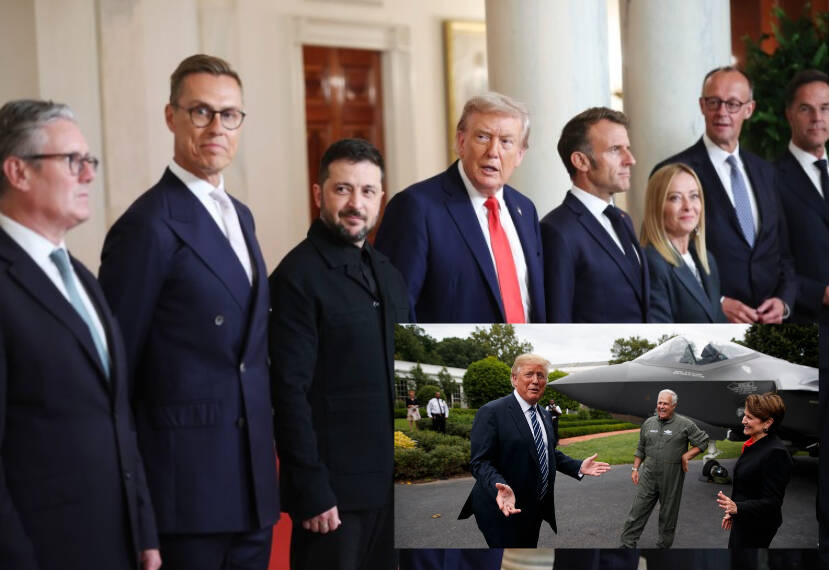As Ukraine continues to face mounting challenges in its defense against Russia, a new push from European allies has emerged to secure American military backing — not through ground troops, but through an ambitious “security guarantee” involving advanced weaponry, intelligence support, and the deployment of U.S. air power.
According to a report in The Times, European nations are lobbying Washington to station F‑35 stealth fighter jets in Romania, enhance air defense capabilities in the region, and grant increased access to Black Sea intelligence through reconnaissance flights. This proposed arrangement falls short of full NATO membership for Ukraine but seeks to build a credible deterrence framework around it.
By creating what some officials describe as a “mini-NATO” structure of bilateral and multilateral guarantees, the West hopes to give Ukraine the tools to defend itself while avoiding a direct NATO-Russia confrontation.
Mini NATO defence for Ukraine
The term “mini-NATO” in this context refers to a proposed informal alliance or security arrangement designed to protect Ukraine without granting it full NATO membership. It’s not an official organization, but rather a collection of military commitments and coordinated efforts by Western nations — primarily the U.S., UK, France, Germany, and other European allies — aimed at providing Ukraine with substantial defensive support. This includes supplying advanced weapons systems, sharing real-time intelligence, conducting surveillance operations over the Black Sea, and potentially deploying F‑35 fighter jets and air-defense systems like Patriots and NASAMS in nearby countries such as Romania.
These measures are intended to mimic some of NATO’s protective features, especially in terms of deterrence, but without invoking the alliance’s Article 5 mutual defense clause, which could trigger a direct conflict with Russia.
The reason for developing this “mini-NATO” model is largely political and strategic. Ukraine’s path to full NATO membership remains blocked due to internal divisions within the alliance and the high risk of escalating the war with Russia. Several NATO members are reluctant to take on the obligation of defending Ukraine militarily under Article 5, especially while the war is ongoing.
At the same time, the West recognizes the need to offer Ukraine credible, long-term security assurances that go beyond symbolic support. This proposed arrangement allows a coalition of willing countries to coordinate defense efforts and offer meaningful protection to Ukraine — through air support, arms supplies, troop training, and defense industry partnerships — while avoiding the political and military risks of full NATO integration.
In essence, the “mini-NATO” concept reflects a shift toward a flexible, multilayered security framework for Ukraine. It aims to deter Russia by positioning Western assets near Ukraine, enabling fast reaction capabilities, and building up Ukraine’s own military resilience. Though it lacks the legal obligations of NATO, it is designed to deliver many of the same strategic benefits through coordinated but unofficial cooperation.
Trump Rules Out Troops, Keeps Air Support “On the Table”
Meanwhile US President Donald Trump has publicly stated he is opposed to deploying American troops in Ukraine. However, in comments made during a recent press briefing, Trump said the U.S. is open to helping “by air” should European forces take the lead on the ground.
“They are willing to put people on the ground,” Trump said. “We’re willing to help them with things — especially, perhaps, by air.”
While his remarks lacked specific operational commitments, White House Press Secretary Karoline Leavitt clarified that air-based support is being actively considered. This could include anything from the use of U.S. drones to enforcement of no-fly zones or stationing air assets in Romania.
European leaders are especially focused on the strategic use of Romania’s Mihail Kogălniceanu Air Base, which has long served as a NATO staging ground in the Black Sea region. By placing U.S. F‑35s at the base — alongside Patriot and NASAMS missile defense systems — NATO allies hope to both deter further Russian advances and provide Ukraine with a reliable defense shield without directly involving NATO in combat.
The proposed package also includes enhanced satellite and airborne surveillance, aiming to bolster Kyiv’s real-time intelligence on Russian troop movements and missile launches.
High-level military talks are already underway between U.S. and European officials to work out the operational and diplomatic implications of this security proposal.
Moscow has reacted with alarm to these developments. Russian officials warned that any NATO or U.S.-based aircraft, missile systems, or reconnaissance operations used in support of Ukraine would be considered legitimate military targets, significantly raising the stakes in what is already one of the most dangerous conflicts in recent history.
This evolving strategy reflects a broader reality: while Ukraine’s path to NATO membership remains blocked, Western powers are increasingly looking for alternative security arrangements that would provide Kyiv with meaningful protection and military support. However these measures can backfire and end up ramping up the clash giving Russia ample evidence that the NATO is indeed bent on moving into the surrounding regions of Russia despite Moscow’s warnings.








